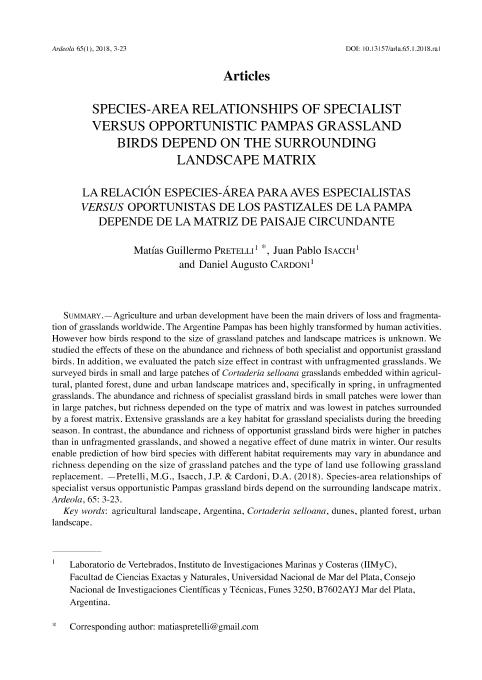Artículo
Agriculture and urban development have been the main drivers of loss and fragmentation of grasslands worldwide. The Argentine Pampas has been highly transformed by human activities. However how birds respond to the size of grassland patches and landscape matrices is unknown. We studied the effects of these on the abundance and richness of both specialist and opportunist grassland birds. In addition, we evaluated the patch size effect in contrast with unfragmented grasslands. We surveyed birds in small and large patches of Cortaderia selloana grasslands embedded within agricultural, planted forest, dune and urban landscape matrices and, specifically in spring, in unfragmented grasslands. The abundance and richness of specialist grassland birds in small patches were lower than in large patches, but richness depended on the type of matrix and was lowest in patches surrounded by a forest matrix. Extensive grasslands are a key habitat for grassland specialists during the breeding season. In contrast, the abundance and richness of opportunist grassland birds were higher in patches than in unfragmented grasslands, and showed a negative effect of dune matrix in winter. Our results enable prediction of how bird species with different habitat requirements may vary in abundance and richness depending on the size of grassland patches and the type of land use following grassland replacement. El desarrollo agrícola y urbano han sido las principales causas de pérdida y fragmentación de los pastizales en todo el mundo. La región Pampeana de Argentina ha sido enormemente transformada por las actividades humanas; sin embargo se desconoce cómo las aves responden al tamaño de los parches de pastizal remanentes y a las matrices de paisaje. Estudiamos ambos efectos sobre la abundancia y riqueza de aves especialistas y oportunistas de pastizal. Además, evaluamos el efecto del tamaño del parche contrastándolo con pastizales sin fragmentar. Muestreamos aves en parches pequeños y grandes de Cortaderia selloana inmersos en matrices agrícolas, forestales, de dunas y urbanas, y específicamente en primavera, en pastizales sin fragmentar. La abundancia y riqueza de aves especialistas en parches pequeños fueron menores que en parches grandes, pero la riqueza dependió del tipo de matriz, y la menor ocurrió en parches rodeados de matriz forestal. Los extensos pastizales son un hábitat clave para las aves especialistas durante la estación reproductiva. Por el contrario, la abundancia y riqueza de aves oportunistas fueron mayores en parches que en pastizales sin fragmentar, y mostraron un efecto negativo de la matriz de dunas durante el invierno. registramos un efecto del tamaño del parche sobre aves especialistas; sin embargo, este efecto estuvo modulado por el uso del suelo que domina el paisaje alrededor de los parches. Nuestros resultados permiten predecir cómo las aves, con diferentes requerimientos de hábitat, pueden variar en abundancia y riqueza dependiendo del tamaño del parche de pastizal y del uso de la tierra derivado de su reemplazo.
Species-area relationships of specialist versus opportunistic Pampas grassland birds depend on the surrounding landscape matrix
Título:
La relación especies-área para aves especialistas versus oportunistas de los pastizales de la Pampa depende de la matriz de paisaje circundante
Fecha de publicación:
01/2018
Editorial:
Sociedad Española de Ornitología
Revista:
Ardeola
ISSN:
0570-7358
Idioma:
Inglés
Tipo de recurso:
Artículo publicado
Clasificación temática:
Resumen
Archivos asociados
Licencia
Identificadores
Colecciones
Articulos(IIMYC)
Articulos de INSTITUTO DE INVESTIGACIONES MARINAS Y COSTERAS
Articulos de INSTITUTO DE INVESTIGACIONES MARINAS Y COSTERAS
Citación
Pretelli, Matías Guillermo; Isacch, Juan Pablo; Cardoni, Daniel Augusto; Species-area relationships of specialist versus opportunistic Pampas grassland birds depend on the surrounding landscape matrix; Sociedad Española de Ornitología; Ardeola; 65; 1; 1-2018; 3-23
Compartir
Altmétricas




